One of the most common inquiries we receive at WordStream is about structuring Google Ads accounts. Today, we’re here to provide you with the ultimate guide to account structure that you’ll ever need!
Creating a successful Google Ads account is similar to constructing a house. You can either start from scratch, building it from the ground up, or renovate an existing account that needs improvement. In some cases, you may even need to demolish a poorly performing campaign and start fresh.
In this comprehensive guide, we’ll walk you through the process of building an effective Google Ads account structure, divided into five key parts:
- The Campaign Level: Establishing a Solid Foundation
- The Ad Group Level: Constructing Your Account
- Keyword Selection: Fine-tuning Your Strategy
- Ad Copy: Enhancing Your Campaign
- Ad Extensions: Expanding Your Reach
By following these steps, you’ll be able to create a well-organized and successful Google Ads campaign structure that will maximize your advertising efforts and that looks something like this:
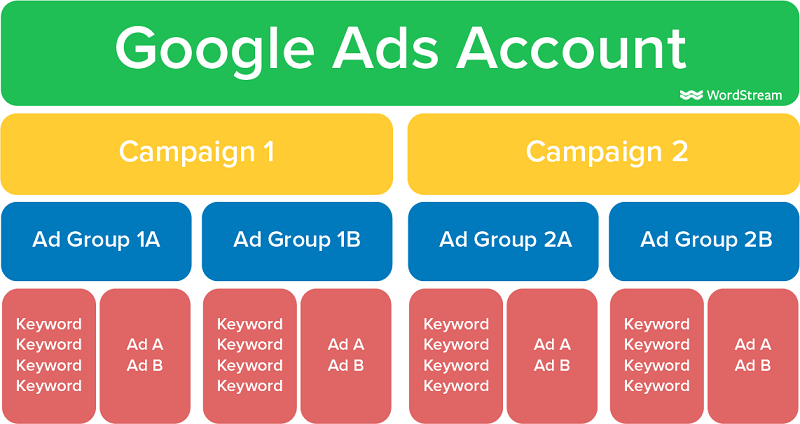
Google Ads Campaign Structure: Laying the Foundation
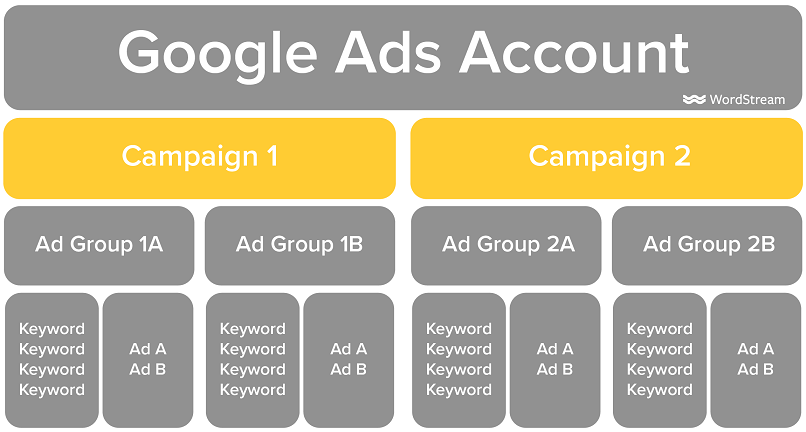
Campaign Type & Settings
To establish a strong foundation for your Google Ads account, it’s important to choose the right campaign type based on your advertising goals. Start by considering the primary objective of your advertising efforts. For most businesses, a search campaign is a suitable choice. However, if your goal is to generate phone calls, such as in the case of an emergency plumber, a call-only campaign would be more appropriate. For generating brand awareness, display campaigns can be highly effective. You can even create multiple campaign types to cater to different objectives.
Once you’ve determined the campaign type, it’s time to plan your blueprint based on the structure of your business.
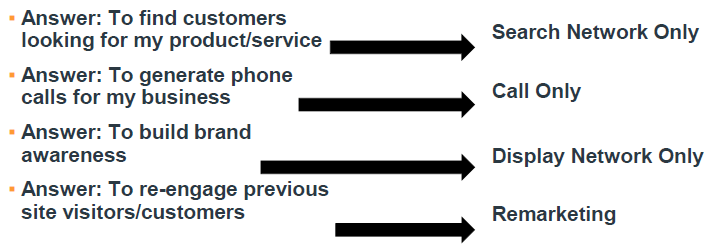
Once you have made those decisions, it is important to carefully consider your campaign settings:
- Location Targeting
- Language Targeting – Any language customers speak
- Bid Strategy – Automatic vs. Manual
- Budget
Setting Up Your Budget
Determining your campaign budget involves careful consideration of your daily budget and estimated cost per click (CPC). Here’s how you can approach it:
- Start with your monthly budget: Decide how much you are willing to spend on your Google Ads campaign per month.
- Calculate your daily budget: Divide your monthly budget by 30.4 (the average number of days in a month) to get your daily budget. This ensures an even distribution of your budget throughout the month.
- Estimate your cost per click (CPC): Research and analyze keywords relevant to your campaign to get an idea of the average CPC for those keywords. This can vary depending on factors such as competitiveness and industry.
- Determine the number of clicks per day: Divide your daily budget by the estimated CPC to calculate the approximate number of clicks your budget can support each day.
- Adjust your budget and bidding strategy: Based on your estimated clicks per day, assess if it aligns with your campaign goals and expectations. You may need to adjust your budget or bidding strategy (e.g., increase or decrease bids) to optimize your campaign’s performance and ensure your budget is being allocated effectively.
Remember to regularly monitor and adjust your budget based on the performance and results of your campaigns. It’s important to stay flexible and make necessary changes to achieve your advertising goals within your budget constraints.
The Ad Group Level: Building Your Structure
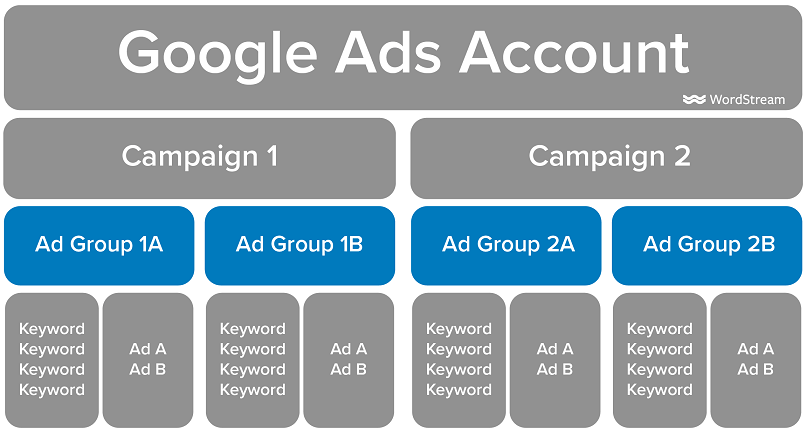
What you can accomplish with ad groups
Ad groups play a crucial role in the structure of your Google Ads account. Here’s what you need to know about ad groups:
- Structure within each campaign: Ad groups provide a way to organize your keywords, ads, and targeting settings within each campaign. They help you group related elements together for better management and optimization.
- Organized by theme: Ad groups are typically organized around a specific theme or topic related to your products or services. This allows you to create targeted ads and choose relevant keywords for each group.
- Control keyword/ad association: Within an ad group, you can associate specific keywords with corresponding ads. This ensures that your ads are highly relevant to the keywords triggering them, resulting in better ad performance and user experience.
By carefully organizing your ad groups and aligning them with your campaign goals and target audience, you can achieve better control over your advertising efforts and improve the overall effectiveness of your Google Ads campaigns.
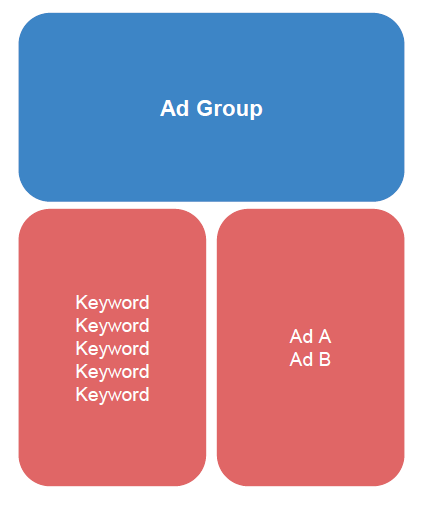
The golden ratios of ad groups
Determining the size of your ad groups is an important aspect of campaign management. While there may be exceptions, here are some general guidelines to follow:
- Number of ad groups per campaign: It’s recommended to have a maximum of 7-10 ad groups per campaign. This allows for better organization and easier management of your advertising efforts.
- Number of keywords per ad group: Aim for a maximum of around 20 keywords per ad group. This helps ensure that your ad groups remain focused and relevant to specific themes or topics.
- Number of ads per ad group: Include 2-3 ads per ad group to test different messaging and variations. This allows you to gather data on ad performance and optimize your campaigns accordingly.
Following these guidelines helps prevent ad groups from becoming overly complex or difficult to manage. By maintaining a manageable size for your ad groups, you can effectively track performance, make adjustments, and improve the overall success of your Google Ads campaigns.
Keywords Selection
Now it’s time to define your keywords, the level under your ad groups.
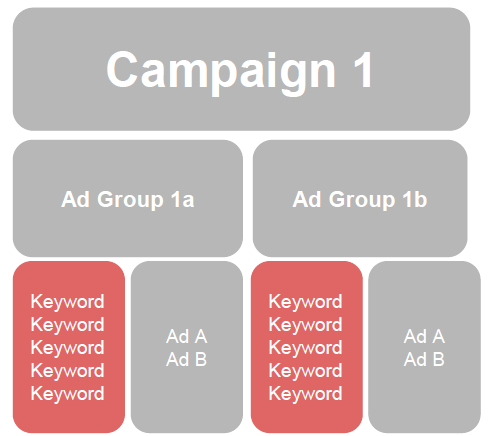
Instead of relying solely on your instincts, it’s recommended to use keyword research tools to ensure you’re bidding on keywords with sufficient search volume. Google Ads provides the Keyword Planner tool within your account, which can help you discover relevant keywords and estimate their search volume.
The key to effective keyword research lies in understanding user intent. It’s crucial to select keywords that demonstrate clear commercial intent, indicating that users are actively seeking to make a purchase. Keywords with strong intent often include:
-Qualifying terms like specific product details, brand names, or the word “cost”
-Location-specific terms, such as “used cars Seattle” In general, broad terms without specific intent tend to yield low click-through and conversion rates, resulting in higher costs per acquisition (CPA).
By focusing on keywords that indicate clear intent, you can optimize your Google Ads campaigns for better performance and improved ROI.
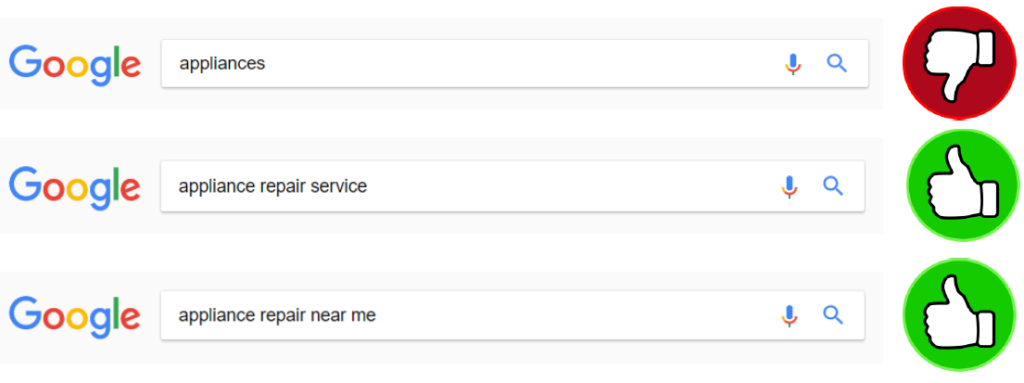
Keyword match types
Keyword match types play a crucial role in determining how your keywords match with user search queries on Google. There are four match types available, listed below from least to most restrictive:
- Broad match: Allows your ad to appear for searches that are generally related to your keyword, including synonyms. For example, if you use broad match for “laptop case,” your ad may show up for searches like “computer bags.”
- Modified broad match: This match type is more restrictive than broad match. It requires the inclusion of specific words designated by a plus sign (+) in the search term, but the words can appear in any order. Learn more about modified broad match here.
- Phrase match: The keyword must include the terms you’re bidding on in the same order, but it can also include other words before or after. For instance, if you have a phrase match for “laptop case,” your ad may appear for searches like “buy laptop case” or “laptop case reviews.”
- Exact match: This match type is the most specific. It requires an exact match between the keyword and the search query, without any additional words or variations.
Google recently introduced changes to the functionality of exact match keywords. The update means that exact match keywords are no longer strictly limited to the exact search term. Instead, your ad may be shown when the order of the terms in your keyword is rearranged or when there are changes to certain “function words.” Here are some examples to illustrate this change:
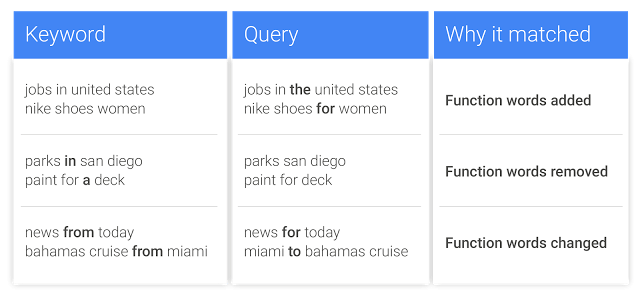
What’s the impact of this change?
- Better for low-volume terms/niche industries
- Not so good for Branded campaigns
As an example: the brand term HomeRate Mortgage now matches the non-branded search “home mortgage rates.”
So what’s the best match type?
The optimal match type to use depends on your specific account goals, but in our personal opinion, modified broad match is highly effective:
- It captures a broad range of related searches, regardless of the order or use of additional terms.
- It maintains relevance by being more restrictive compared to broad match.
- Consider using 2-3 term keywords for better precision. It’s advisable to avoid single-term keywords for more targeted results.
Max CPC bids
Setting maximum cost-per-click (CPC) bids is an important aspect of keyword optimization. This bid determines the maximum amount you are willing to pay for a click on your ad. Your ad position and cost-per-click are influenced by your maximum CPC bid and your Quality Score, resulting in your Ad Rank.
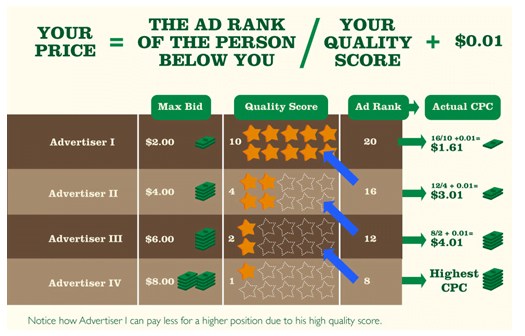
Similar to setting your budget, determining the initial Max CPC bids for a new campaign can be a question of where to begin. There are a few effective approaches to help you determine the appropriate starting point for your Max CPC bids.
There are two main options to consider when determining your Max CPC bids for a new campaign: Automatic Bidding and Manual CPC.
Option 1: Automatic Bidding
Although Manual bidding provides more control, starting with Automatic bidding can be beneficial for a new campaign. By allowing Google to determine your Max CPC bids initially, you can gather data and gain insights into the cost of clicks. Once you have sufficient data, you can switch back to Manual bidding.
Here are some guidelines for using Automatic bidding:
- Choose the “Maximize Clicks” bid strategy, which aims to maximize the number of clicks within your daily budget.
- Set a Max CPC bid limit to prevent Google from exceeding a certain bid threshold for a single click.
Option 2: Manual CPC
If you prefer complete control over your bids, you can opt for the Manual CPC bidding strategy from the start. To determine your initial Max CPC bids, you can rely on two metrics provided by Google: Page #1 CPC and Top of Page CPC. These estimations indicate the approximate cost of ranking on the first page of search results and at the top of that page. Setting your Max CPC bids between these numbers is often a good starting point when using Manual bidding.
Ad Copy
Now we arrive at the fourth part of this guide, which involves writing your ad copy. This is the aspect of your account that will be most visible to people.
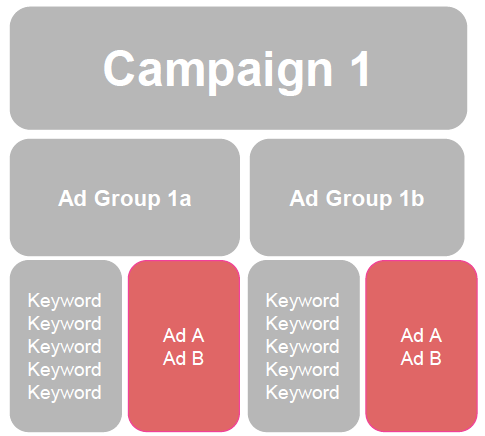
First and foremost, it’s important to note that we are now in an era of Expanded Text Ads (ETAs). These have become the default ad type, and they offer approximately double the size of the traditional Google text ads we were accustomed to.
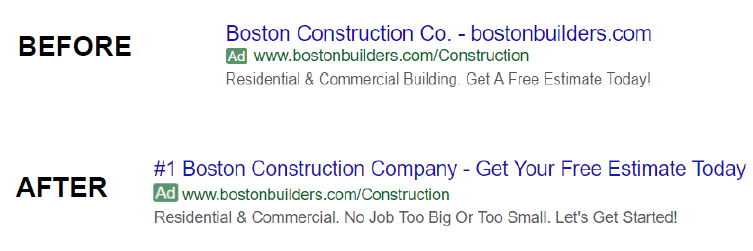
Ensure that you adhere to the best practices for Expanded Text Ads (ETAs) and take note of these dos and don’ts to maximize the effectiveness of your ETAs.
Ad copy A/B testing

In your ad variations, try one version that features straightforward, keyword-centric ad copy and another version that takes a more creative and attention-grabbing approach. Don’t assume you know how your audience will respond – instead, run a test and gather conclusive data to determine the most effective ad copy for your campaign.
Test Price vs No Price
Another thing to test: including a pricing information in your ad.

Using specific numbers in your ad copy can be effective in driving clicks and capturing the attention of your audience. Additionally, it can help you qualify your audience by filtering out individuals who may not be genuinely interested in your market, such as those seeking luxury products.
Crafting ad copy that is optimized for conversions
Ensure your ad copy is designed to drive conversions. Here are a few tips:
Utilize self-selecting ad copy: Including pricing information can help attract your target audience and discourage clicks from those who are not interested in making a purchase.
Align your call to action (CTA) with your landing page: When your ad and landing page feature the same CTA, it creates a cohesive experience and increases the likelihood of conversions even before users click on your ad. Take a look at the example below, where the ad and landing page have excellent “message match”:

Now look at the landing page:
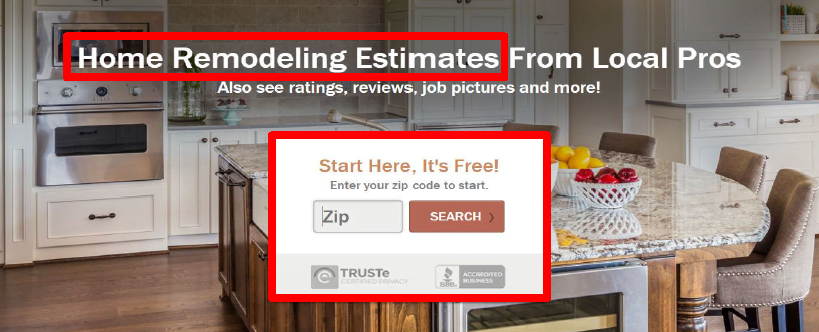
Ad Extensions
Ad extensions are a reliable way to enhance the appeal of your ad, increasing click-through rates without incurring additional costs (unfortunately, they won’t add a pool to your account).
Now, which extensions should you use? With numerous extensions available and new ones being introduced regularly, not all of them will be suitable for your account. However, here are my top four favorite extensions:
- Sitelinks: These are versatile and can be used in various contexts. Sitelinks provide clickable links to different pages on your website, giving searchers more options beyond a single landing page. However, if you primarily use static lead capture landing pages, it may be best to avoid using sitelinks.
- Callout extensions: These allow you to add extra snippets of text that appear as an additional line of copy in your ad. Although they are not clickable, callout extensions provide an opportunity to highlight key features or benefits.
- Call extensions: If driving phone calls is an essential goal for your business, call extensions enable searchers to call your business directly from the ad, making it convenient for users to connect with you.
- Location extensions: Particularly useful for businesses with physical locations, location extensions display your business address, making it easier for potential customers to find and visit your establishment.
By strategically utilizing these extensions, you can enhance the effectiveness of your ads and provide additional information to potential customers.
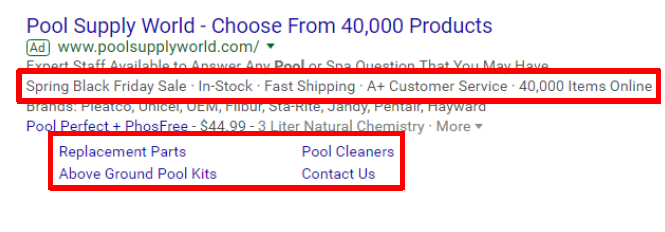
Call extensions and location extensions are not always applicable, but they can be highly beneficial in certain scenarios. Call extensions are particularly useful for mobile users as they allow them to directly call your business from the search engine results page (SERP), bypassing the need to visit a landing page. On the other hand, location extensions provide valuable information about your physical business, making them a valuable addition for local businesses looking to attract customers who are specifically searching for nearby options.
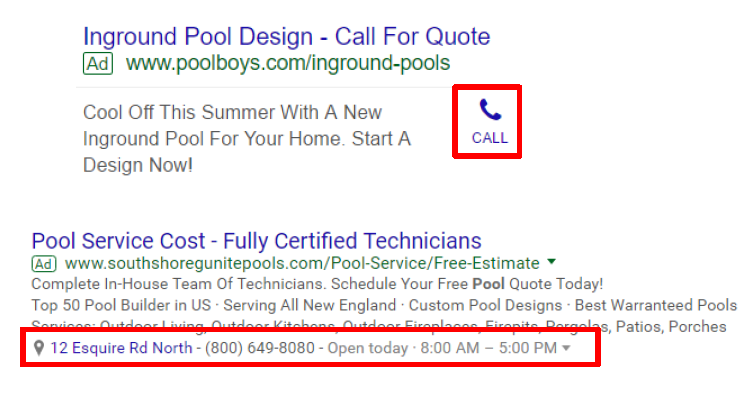
Consider exploring other extensions based on your specific business type. These extensions offer several advantages, including:
- Facilitating a more streamlined path to conversion
- Occupying additional space on the search engine results page
- Enhancing your Quality Score by increasing your click-through rate
Make sure to include these extensions in your ad campaign for optimal results.
Google Ads Account Structure (Simplified Summary)
Whether you’re starting a new Google Ads account or revamping an existing one, here are the key takeaways to keep in mind:
- Build a strong foundation: Pay attention to your campaign structure and settings to ensure a solid starting point.
- Harness the power of ad groups: Use them to control the association between keywords and ads effectively.
- Optimize your keyword selection: Start with modified broad match keywords that demonstrate clear intent and include 2-3 relevant terms.
- Craft conversion-focused ad copy: Create compelling ads that lead to higher conversions and continuously test different variations.
- Embrace ad extensions: Choose the right extensions for your campaigns to enhance visibility, improve click-through rates, and drive better results.
Remember, these strategies will help you establish a solid Google Ads account and optimize its performance.
